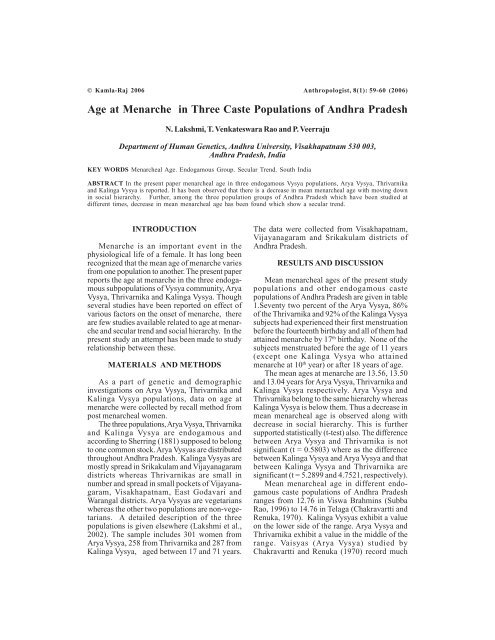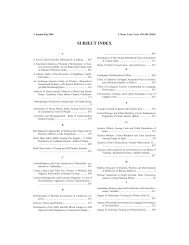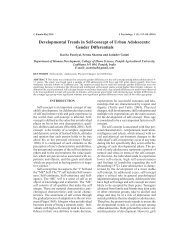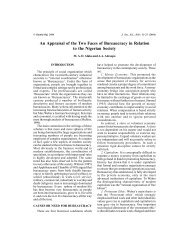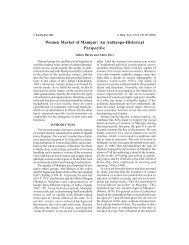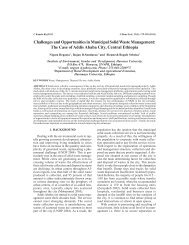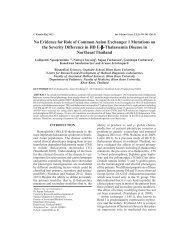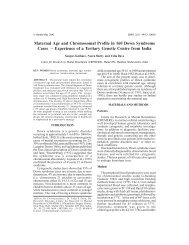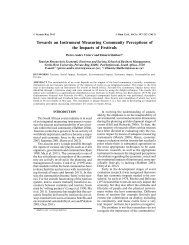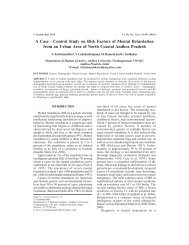Age at Menarche in Three Caste Populations of Andhra Pradesh
Age at Menarche in Three Caste Populations of Andhra Pradesh
Age at Menarche in Three Caste Populations of Andhra Pradesh
You also want an ePaper? Increase the reach of your titles
YUMPU automatically turns print PDFs into web optimized ePapers that Google loves.
© Kamla-Raj 2006 Anthropologist, 8(1): 59-60 (2006)<br />
<strong>Age</strong> <strong>at</strong> <strong>Menarche</strong> <strong>in</strong> <strong>Three</strong> <strong>Caste</strong> Popul<strong>at</strong>ions <strong>of</strong> <strong>Andhra</strong> <strong>Pradesh</strong><br />
N. Lakshmi, T. Venk<strong>at</strong>eswara Rao and P. Veerraju<br />
Department <strong>of</strong> Human Genetics, <strong>Andhra</strong> University, Visakhap<strong>at</strong>nam 530 003,<br />
<strong>Andhra</strong> <strong>Pradesh</strong>, India<br />
KEY WORDS <strong>Menarche</strong>al <strong>Age</strong>. Endogamous Group. Secular Trend. South India<br />
ABSTRACT In the present paper menarcheal age <strong>in</strong> three endogamous Vysya popul<strong>at</strong>ions, Arya Vysya, Thrivarnika<br />
and Kal<strong>in</strong>ga Vysya is reported. It has been observed th<strong>at</strong> there is a decrease <strong>in</strong> mean menarcheal age with mov<strong>in</strong>g down<br />
<strong>in</strong> social hierarchy. Further, among the three popul<strong>at</strong>ion groups <strong>of</strong> <strong>Andhra</strong> <strong>Pradesh</strong> which have been studied <strong>at</strong><br />
different times, decrease <strong>in</strong> mean menarcheal age has been found which show a secular trend.<br />
INTRODUCTION<br />
<strong>Menarche</strong> is an important event <strong>in</strong> the<br />
physiological life <strong>of</strong> a female. It has long been<br />
recognized th<strong>at</strong> the mean age <strong>of</strong> menarche varies<br />
from one popul<strong>at</strong>ion to another. The present paper<br />
reports the age <strong>at</strong> menarche <strong>in</strong> the three endogamous<br />
subpopul<strong>at</strong>ions <strong>of</strong> Vysya community, Arya<br />
Vysya, Thrivarnika and Kal<strong>in</strong>ga Vysya. Though<br />
several studies have been reported on effect <strong>of</strong><br />
various factors on the onset <strong>of</strong> menarche, there<br />
are few studies available rel<strong>at</strong>ed to age <strong>at</strong> menarche<br />
and secular trend and social hierarchy. In the<br />
present study an <strong>at</strong>tempt has been made to study<br />
rel<strong>at</strong>ionship between these.<br />
MATERIALS AND METHODS<br />
As a part <strong>of</strong> genetic and demographic<br />
<strong>in</strong>vestig<strong>at</strong>ions on Arya Vysya, Thrivarnika and<br />
Kal<strong>in</strong>ga Vysya popul<strong>at</strong>ions, d<strong>at</strong>a on age <strong>at</strong><br />
menarche were collected by recall method from<br />
post menarcheal women.<br />
The three popul<strong>at</strong>ions, Arya Vysya, Thrivarnika<br />
and Kal<strong>in</strong>ga Vysya are endogamous and<br />
accord<strong>in</strong>g to Sherr<strong>in</strong>g (1881) supposed to belong<br />
to one common stock. Arya Vysyas are distributed<br />
throughout <strong>Andhra</strong> <strong>Pradesh</strong>. Kal<strong>in</strong>ga Vysyas are<br />
mostly spread <strong>in</strong> Srikakulam and Vijayanagaram<br />
districts whereas Thrivarnikas are small <strong>in</strong><br />
number and spread <strong>in</strong> small pockets <strong>of</strong> Vijayanagaram,<br />
Visakhap<strong>at</strong>nam, East Godavari and<br />
Warangal districts. Arya Vysyas are vegetarians<br />
whereas the other two popul<strong>at</strong>ions are non-vegetarians.<br />
A detailed description <strong>of</strong> the three<br />
popul<strong>at</strong>ions is given elsewhere (Lakshmi et al.,<br />
2002). The sample <strong>in</strong>cludes 301 women from<br />
Arya Vysya, 258 from Thrivarnika and 287 from<br />
Kal<strong>in</strong>ga Vysya, aged between 17 and 71 years.<br />
The d<strong>at</strong>a were collected from Visakhap<strong>at</strong>nam,<br />
Vijayanagaram and Srikakulam districts <strong>of</strong><br />
<strong>Andhra</strong> <strong>Pradesh</strong>.<br />
RESULTS AND DISCUSSION<br />
Mean menarcheal ages <strong>of</strong> the present study<br />
popul<strong>at</strong>ions and other endogamous caste<br />
popul<strong>at</strong>ions <strong>of</strong> <strong>Andhra</strong> <strong>Pradesh</strong> are given <strong>in</strong> table<br />
1.Seventy two percent <strong>of</strong> the Arya Vysya, 86%<br />
<strong>of</strong> the Thrivarnika and 92% <strong>of</strong> the Kal<strong>in</strong>ga Vysya<br />
subjects had experienced their first menstru<strong>at</strong>ion<br />
before the fourteenth birthday and all <strong>of</strong> them had<br />
<strong>at</strong>ta<strong>in</strong>ed menarche by 17 th birthday. None <strong>of</strong> the<br />
subjects menstru<strong>at</strong>ed before the age <strong>of</strong> 11 years<br />
(except one Kal<strong>in</strong>ga Vysya who <strong>at</strong>ta<strong>in</strong>ed<br />
menarche <strong>at</strong> 10 th year) or after 18 years <strong>of</strong> age.<br />
The mean ages <strong>at</strong> menarche are 13.56, 13.50<br />
and 13.04 years for Arya Vysya, Thrivarnika and<br />
Kal<strong>in</strong>ga Vysya respectively. Arya Vysya and<br />
Thrivarnika belong to the same hierarchy whereas<br />
Kal<strong>in</strong>ga Vysya is below them. Thus a decrease <strong>in</strong><br />
mean menarcheal age is observed along with<br />
decrease <strong>in</strong> social hierarchy. This is further<br />
supported st<strong>at</strong>istically (t-test) also. The difference<br />
between Arya Vysya and Thrivarnika is not<br />
significant (t = 0.5803) where as the difference<br />
between Kal<strong>in</strong>ga Vysya and Arya Vysya and th<strong>at</strong><br />
between Kal<strong>in</strong>ga Vysya and Thrivarnika are<br />
significant (t = 5.2899 and 4.7521, respectively).<br />
Mean menarcheal age <strong>in</strong> different endogamous<br />
caste popul<strong>at</strong>ions <strong>of</strong> <strong>Andhra</strong> <strong>Pradesh</strong><br />
ranges from 12.76 <strong>in</strong> Viswa Brahm<strong>in</strong>s (Subba<br />
Rao, 1996) to 14.76 <strong>in</strong> Telaga (Chakravartti and<br />
Renuka, 1970). Kal<strong>in</strong>ga Vysyas exhibit a value<br />
on the lower side <strong>of</strong> the range. Arya Vysya and<br />
Thrivarnika exhibit a value <strong>in</strong> the middle <strong>of</strong> the<br />
range. Vaisyas (Arya Vysya) studied by<br />
Chakravartti and Renuka (1970) record much
60<br />
higher mean menarcheal age when compared to<br />
the present study Arya Vysya popul<strong>at</strong>ions.<br />
The Brahm<strong>in</strong>s, Ksh<strong>at</strong>riyas and Arya Vysyas<br />
<strong>in</strong> Table 1 belong to the same area and were<br />
studied by different authors (Chakravartti and<br />
Renuka, 1970; Dharani Priya, 2001; Sita Lakshmi,<br />
2002; Lakshmi et al., present study) <strong>at</strong> different<br />
times with a time lapse <strong>of</strong> 20 to 30 years, almost<br />
equal to one gener<strong>at</strong>ion gap. When the mean<br />
menarcheal ages <strong>of</strong> these popul<strong>at</strong>ions <strong>at</strong> different<br />
periods are compared, a secular trend lead<strong>in</strong>g to<br />
decrease <strong>of</strong> the mean menarcheal age is evident.<br />
Brown (1966) proposed th<strong>at</strong> improvements <strong>in</strong><br />
nutrition and the elim<strong>in</strong><strong>at</strong>ion <strong>of</strong> <strong>in</strong>fectious<br />
diseases (characteristics associ<strong>at</strong>ed with socioeconomic<br />
development) tend to reduce the<br />
average menarcheal age. Several studies (Uche<br />
and Okorafor, 1979, Sidhu and Sidhu, 1987; Bagga<br />
and Kulkarni, 2000; Padez and Rocha, 2003)<br />
reported th<strong>at</strong> improved socio economic st<strong>at</strong>us may<br />
be responsible for early menstru<strong>at</strong>ion. The<br />
Brahm<strong>in</strong>, Ksahtriya and Arya Vysya popul<strong>at</strong>ions<br />
compared <strong>in</strong> the present study experienced a<br />
significant improvement <strong>in</strong> their economic<br />
position and dietary habits over a period <strong>of</strong> 20 to<br />
30 years. Therefore the secular trend by these<br />
popul<strong>at</strong>ions supports the studies mentioned<br />
above.<br />
REFERENCES<br />
Babu, B.V. and Naidu, J.M.: A demographic pr<strong>of</strong>ile <strong>of</strong><br />
four <strong>Andhra</strong> <strong>Caste</strong> popul<strong>at</strong>ions. Ind. J. Phys. Anthrop.<br />
N. LAKSHMI, T. VENKATESWARA RAO AND P. VEERRAJU<br />
Table 1: Mean menarcheal ages <strong>in</strong> present study popul<strong>at</strong>ions and <strong>in</strong> other castes <strong>of</strong> <strong>Andhra</strong> <strong>Pradesh</strong><br />
Popul<strong>at</strong>ion N Mean ± S.E Reference<br />
Arya Vysya 301 13.56 ± 0.06 Present Study<br />
Kal<strong>in</strong>ga Vysya 287 13.04 ± 0.06 Present Study<br />
Thrivarnika 258 13.50 ± 0.07 Present Study<br />
Brahm<strong>in</strong> I 389 14.63 ± 0.48 Chakravartti & Renuka, 1970<br />
Brahm<strong>in</strong> II 631 13.03 ± 0.05 Sita Lakshmi, 2002<br />
Chakali 104 13.01 ± 0.08 Babu & Naidu, 1989<br />
Ediga 104 14.18 ± 0.18 Bhaskar et al, 1986<br />
Kamma 147 14.50 ± 0.32 Chakravartti & Renuka, 1970<br />
Kapu 300 13.70 ± 0.57 Chakravartti & Renuka, 1970<br />
Ksh<strong>at</strong>riya I 40 14.45 ± 0.36 Chakravartti & Renuka, 1970<br />
Ksh<strong>at</strong>riya II 1500 13.86 ± 0.03 Dharani Priya, 2001<br />
Kummari 63 13.33 ± 0.11 Babu & Naidu, 1989<br />
Madiga 92 13.21 ± 0.11 Babu & Naidu, 1989<br />
Mangali 112 13.13 ± 0.08 Babu & Naidu, 1989<br />
Naidu 7 3 14.38 ± 0.45 Chakravartti & Renuka, 1970<br />
Reddi 3 0 13.86 ± 0.25 Chakravartti & Renuka, 1970<br />
Relli 428 13.07 ± 0.05 Ramesh, 1992<br />
Telaga 121 14.76 ± 0.06 Chakravartti & Renuka, 1970<br />
Vaisya 16 14.60 ± 0.52 Chakravartti & Renuka, 1970<br />
Viswa Brahm<strong>in</strong>s 516 12.76 ± 0.06 Subba Rao,1996<br />
& Hum.Genet., 15: 97-102 (1989).<br />
Bagga, A. and Kulkarni, S.: <strong>Age</strong> <strong>at</strong> menarche and secular<br />
trend <strong>in</strong> Maharastrian (Indian) girls. Acta Biological<br />
Szegediensis, 44: 53-57 (2000).<br />
Bhaskar, S. Vasulu, T.S. and Damodharan, K.:<br />
Demographic structure <strong>of</strong> Ediga. A backward<br />
community <strong>of</strong> Chittoor district, South India. Ind. J.<br />
Phys. Anthrop. & Hum. Genet., 12: 51-59 (1986).<br />
Brown, P.E.: The age <strong>at</strong> menarche. British J. Preventive<br />
& Soc. Med., 20: 9-14 (1966).<br />
Chakravartti, M.R. and Renuka, Y.: The trend <strong>of</strong> age <strong>at</strong><br />
menarche <strong>in</strong> India. J. Soc.Res., 13: 82-94 (1970).<br />
Dharani Priya, B.: A Study <strong>of</strong> Genetic Demography <strong>of</strong><br />
The Ksh<strong>at</strong>riyas. Ph. D. Thesis, <strong>Andhra</strong> University<br />
(2001).<br />
Lakshmi, N. Demarchi, D. Veeraju, P. and Venk<strong>at</strong>eswara Rao,<br />
T.: Popul<strong>at</strong>ion structure and genetic differenti<strong>at</strong>ion<br />
among the sub-structured Vysya <strong>Caste</strong> popul<strong>at</strong>ion <strong>in</strong><br />
comparison to the other popul<strong>at</strong>ions <strong>of</strong> <strong>Andhra</strong><br />
<strong>Pradesh</strong>, India. Ann. Hum. Biol., 29: 538-549 (2002).<br />
Padez, C. and Rocha, M.A.: <strong>Age</strong> <strong>at</strong> menarche <strong>in</strong> Coimbra<br />
(Portugal) school girls: a note on the secular changes.<br />
Ann. Hum. Biol., 30: 622-632 (2003).<br />
Ramesh, M.: A Genetic Study <strong>of</strong> the Rellis. Ph.D. Thesis,<br />
<strong>Andhra</strong> University (1992).<br />
Sherr<strong>in</strong>g, M.A.: H<strong>in</strong>du Tribes and <strong>Caste</strong>s-The<br />
Brahm<strong>in</strong>ical Tribes <strong>of</strong> the Madras Presidency. Vol.<br />
II. Cosmo Public<strong>at</strong>ions, Delhi, pp.105-107 (1881).<br />
Sidhu. S. and Sidhu L.S.: <strong>Age</strong> <strong>at</strong> menarche and menopause<br />
<strong>in</strong> Sansi females <strong>of</strong> Punjab. Ind. J. Phys. Anthrop. Hum.<br />
Genet., 13: 237-242 (1987).<br />
Sita Lakshmi, D.: A Study on Genetic Demography <strong>of</strong><br />
Brahm<strong>in</strong>s with Social Reference to Temporal Trends <strong>in</strong><br />
Consangu<strong>in</strong>ity and Consequences. Ph. D. Thesis,<br />
<strong>Andhra</strong> University (2002).<br />
Subba Rao, I.: A Popul<strong>at</strong>ion Genetic Study <strong>of</strong> the Viswa<br />
Brahm<strong>in</strong>s. Ph.D. Thesis, <strong>Andhra</strong> University (1996)<br />
Uche, G.O. and Okorafor, A.E.: The age <strong>of</strong> menarche <strong>in</strong><br />
Nigerian Urban school girls. Ann. Hum. Biol., 6:<br />
395-396 (1979).


